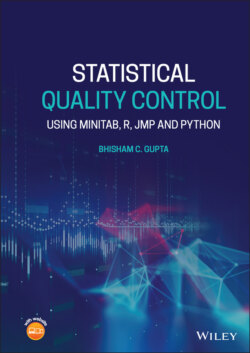Читать книгу Statistical Quality Control - Bhisham C. Gupta - Страница 23
Definition 1.1
ОглавлениеA process may be defined as a series of actions or operations that change the form, fit, or function of one or more input(s) as required by a customer. A process may also be defined as a combination of workforce, equipment, raw material, methods, and environment that work together to produce a product. Figure 1.1 shows various steps that usually take place in any process, whether in a manufacturing or non‐manufacturing environment.
The quality of the final product depends on how the process to be used is designed and executed.
The concept of SQC is less than a century old. Dr. Walter Shewhart (1931), working at the Westinghouse Hawthorne plant in Cicero, Illinois, drew the first statistical process control (SPC) chart in 1924. While working at Hawthorne, Shewhart met and influenced W. Edward Deming and Joseph Juran; later, they went on to champion Shewhart's methods. Shewhart, Deming, and Juran are often considered the three founders of the quality improvement movement.
Figure 1.1 Flow chart of a process.
As mentioned above, SQC is a set of statistical tools used to monitor, control, and improve process performance. These essential tools are (i) SPC, (ii) acceptance sampling plans, and (iii) design of experiments (DOE). DOE is used to improve the process and find important control factors, whereas SPC monitors these factors so that the process remains in a steady state. SPC is one of the important tools that makes up SQC. However, the term statistical process control is often used interchangeably with statistical quality control.
